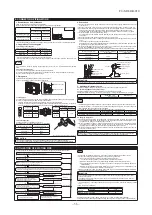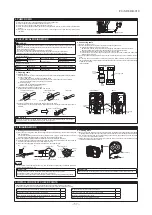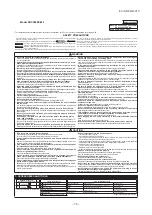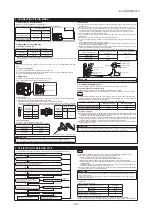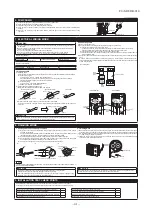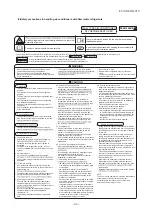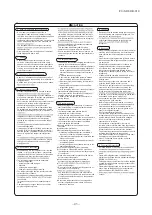
• This installation manual deals with an outdoor unit installation only. For an indoor unit installation, refer to page 30.
SAFETY PRECAUTIONS
• Before installation, read the “SAFETY PRECAUTIONS” carefully and strictly follow it during the installa-
tion work in order to protect yourself.
• The precautionary items mentioned below are distinguished into two levels,
WARNING
and
CAUTION
.
WARNING
Indicates a potentially hazardous situation which, if not avoided, can result in serious con-
sequences such as death or severe injury.
CAUTION
Indicates a potentially hazardous situation which, if not avoided, can result in personal
injury or property damage.
Both mention the important items to protect your health and safety. Therefore, strictly follow them by any means.
• Be sure to confirm no operation problem on the equipment after completing the installation. If unusual
noise can be heard during the test run, consult the dealer.
• Be sure to explain the operating methods as well as the maintenance methods of this equipment to the
user according to the user’s manual.
• Be sure to keep the installation manual together with user’s manual at a place where it is easily accessi-
ble to the user any time. Moreover, ask the user to hand the manuals to a new user, whenever required.
WARNING
• Be sure to use only for residential purpose.
If this unit is installed in inferior environment such as machine shop, vehicle (like ship), warehouse,
etc., it can malfunction.
• Installation must be carried out by the qualified installer completely in accor-
dance with the installation manual.
Installation by non qualified person or incorrect installation can cause serious troubles such as water
leak, electric shock, fire and personal injury.
• Be sure to wear protective goggles and gloves while performing installation work.
Improper safety measures can result in personal injury.
• Use the original accessories and the specified components for the installation.
Using parts other than those prescribed may cause water leak, electric shock, fire and personal injury.
• Do not install the unit near the location where leakage of flammable gases can occur.
If leaked gases accumulate around the unit, it can cause fire resulting in property damage and
personal injury.
• When installing the unit in small rooms, make sure that refrigerant density
does not exceed the limit (Reference: ISO5149) in the event of leakage.
If refrigerant density exceeds the limit, consult the dealer and install the ventilation system.
Otherwise lack of oxygen can occur resulting in serious accident.
• Install the unit in a location where unit will remain stable, horizontal and free
of any vibration transmission.
Unsuitable installation location can cause the unit to fall resulting in material damage and personal injury.
• Do not run the unit with removed panels or protections.
Touching rotating equipments, hot surfaces or high voltage parts can cause personal injury due to
entrapment, burn or electric shock.
• This unit is designed specifically for R32.
Using any other refrigerant can cause unit failure and personal injury.
• Do not vent R32 into atmosphere.
R32
is a fluorinated greenhouse gas with a Global Warming Potential (GWP) = 675.
• Make sure that no air enters the refrigerant circuit when the unit is installed
and removed.
If air enters the refrigerant circuit, the pressure in the refrigerant circuit will become too high, which
can cause burst and personal injury.
• Be sure to use the prescribed pipes, flare nuts and tools for R32 or R410A.
Using existing parts (for R22 or R407C) can cause refrigerant circuit burst resulting in unit failure and
personal injury.
• Be sure to connect both liquid and gas connecting pipes properly before
operating the compressor.
Do not open the liquid and gas service valves before completing piping work,
and evacuation.
If the compressor is operated when connecting pipes are not connected and service valves are open,
air can be sucked into the refrigerant circuit which can cause anomalous high pressure resulting in
burst or personal injury.
• Be sure to tighten the flare nuts to specified torque using the torque wrench.
Tightening flare nuts with excess torque can cause burst and refrigerant leakage after a long period.
• During pump down work, be sure to stop the compressor before closing ser-
vice valves and removing connecting pipes.
If the connecting pipes are removed when the compressor is in operation and service valves are
open, air can be sucked into the refrigerant circuit which can cause anomalous high pressure
resulting in burst or personal injury.
• In the event of refrigerant leakage during installation, be sure to ventilate the
working area properly.
If the refrigerant comes into contact with naked flames, poisonous gases will be produced.
• Electrical work must be carried out by the qualified electrician, strictly in
accordance with national or regional electricity regulations.
Incorrect installation can cause electric shock, fire or personal injury.
• Make sure that earth leakage breaker and circuit breaker of appropriate
capacities are installed.
Circuit breaker should be able to disconnect all poles under over current. Absence of appropriate
breakers can cause electric shock, personal injury or property damage.
• Be sure to switch off the power source in the event of installation, mainte-
nance or service.
If the power source is not switched off, there is a risk of electric shock, unit failure or personal injury.
• Be sure to tighten the cables securely in terminal block and relieve the
cables properly to prevent overloading the terminal blocks.
Loose connections or cable mountings can cause anomalous heat production or fire.
• Do not process, splice or modify the power cable, or share the socket with
other power plugs.
Improper power cable or power plug can cause fire or electric shock due to poor connection, insuffi-
cient insulation or over-current.
• Do not perform any change in protective device or its setup condition yourself.
Changing protective device specifications can cause electric shock, fire or burst.
• Be sure to clamp the cables properly so that they do not touch any internal
component of the unit.
If cables touch any internal component, it can cause overheating and fire.
• Be sure to install service cover properly.
Improper installation can cause electric shock or fire due to intrusion of dust or water.
• Be sure to use the prescribed power and connecting cables for electrical work.
Using improper cables can cause electric leak or fire.
• This appliance must be connected to main power source by means of a
circuit breaker or switch with a contact separation of at least 3 mm.
Improper electrical work can cause unit failure or personal injury.
• Be sure to connect the power source cable with power source properly.
Improper connection can cause intrusion of dust or water resulting in electric shock or fire.
CAUTION
• Take care when carrying the unit by hand.
If the unit weight is more than 20 kg, it must be carried by two or more persons.
Do not carry the unit by the plastic straps. Always use the carry handle.
• Do not install the outdoor unit in a location where insects and small animals
can inhabit.
Insects and small animals can enter the electrical parts and cause damage resulting in fire or person-
al injury. Instruct the user to keep the surroundings clean.
• If the outdoor unit is installed at height, make sure that there is enough
space for installation, maintenance and service.
Insufficient space can result in personal injury due to falling from the height.
• Do not install the unit near the location where neighbours are bothered by
noise or air generating from the unit.
It can affect surrounding environment and cause a claim.
• Do not install in the locations where unit is directly exposed to corrosive
gases (like sulphide gas, chloride gas), sea breeze or salty atmosphere.
It can cause corrosion of heat exchanger and damage to plastic parts.
• Do not install the unit close to the equipments that generate electromagnetic
waves and/or high-harmonic waves.
Equipment such as inverters, standby generators, medical high frequency equipments and telecom-
munication equipments can affect the system, and cause malfunctions and breakdowns.
The system can also affect medical equipment and telecommunication equipment, and obstruct its
function or cause jamming.
• Do not install the unit in the locations where:
• There are heat sources nearby.
• Unit is directly exposed to rain or sunlight.
• There is any obstacle which can prevent smooth air circulation from inlet and outlet side of the unit.
• Unit is directly exposed to oil mist and steam such as kitchen.
• Chemical substances like ammonia (organic fertilizer), calcium chloride (snow melting agent) and
acid (sulfurous acid etc.), which can harm the unit, will generate or accumulate.
• Drain water can not be discharged properly.
• TV set or radio receiver is placed within 1 m.
• Height above sea level is more than 1000 m.
It can cause performance degradation, corrosion and damage of components, unit malfunction and fire.
• Dispose of all packing materials properly.
Packing materials contain nails and wood which can cause personal injury.
Keep the polybag away from children to avoid the risk of suffocation.
• Do not put anything on the outdoor unit.
Object may fall causing property damage or personal injury.
• Do not touch the aluminum fin of the outdoor unit.
Aluminium fin temperature is high during heating operation. Touching fin can cause burn.
• Do not touch any refrigerant pipe with your hands when the system is in operation.
During operation the refrigerant pipes become extremely hot or extremely cold depending on the
operating condition. Touching pipes can cause personal injury like burn (hot/cold).
• Install isolator or disconnect switch on the power source wiring in accor-
dance with the local codes and regulations.
The isolator should be locked in OFF state in accordance with EN60204-1.
RWC012A068G
D
Model SRC20,25,35,50ZS-W
SRC20,25,35ZS-WA
R32 REFRIGERANT USED
1. ACCESSORIES AND TOOLS
Locally procured parts
Tools for installation work
(a) Anchor bolt(M10-M12) × 4 pcs.
Plus headed driver
Spanner wrench
Vacuum pump*
(b) Putty
Knife
Torque wrench [14.0-62.0 N•m(1.4-6.2 kgf•m)]
Gauge manifold *
(c) Electrical tape
Saw
Wrench key (Hexagon) [4 mm]
Charge hose *
(d) Connecting pipe
Tape measure
Flaring tool set *
Vacuum pump adapter*
(Anti-reverse flow type)
(e) Connecting cable
(f) Power cable
Pipe cutter
Flare adjustment gauge
Gas leak detector *
(g)
Clamp and screw (for finishing work)
*Designed specifically for R32 or R410A
Standard accessories
(Supplied with outdoor unit)
Q’ty
(1) Drain grommet
1
(2) Drain elbow
1
*Not included for SRC20, 25, or 35ZS-WA.
(2) Installation of outdoor unit
Models SRC25ZS-W2, 35ZS-W2
'20 • SRF-DB-310
-
34
-



